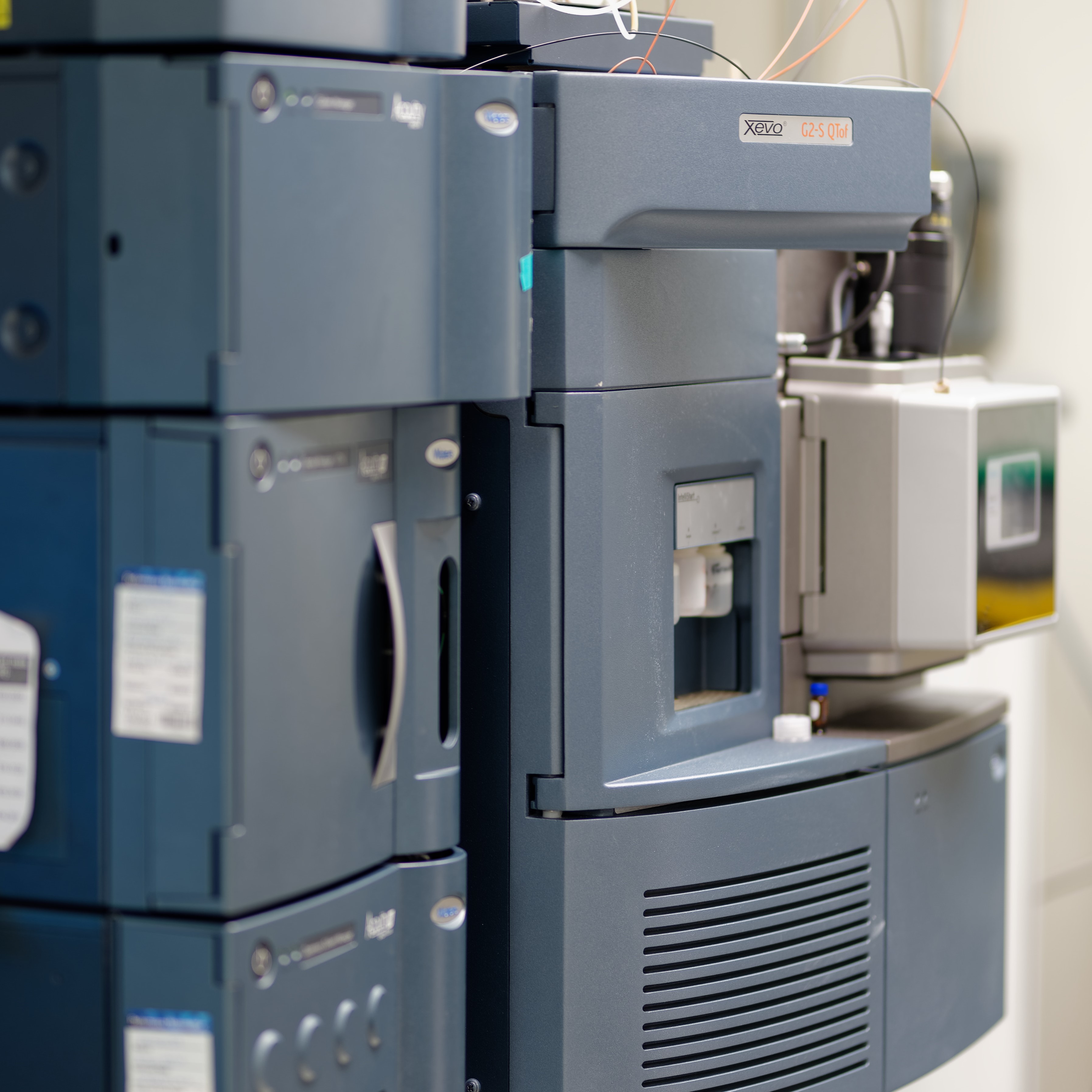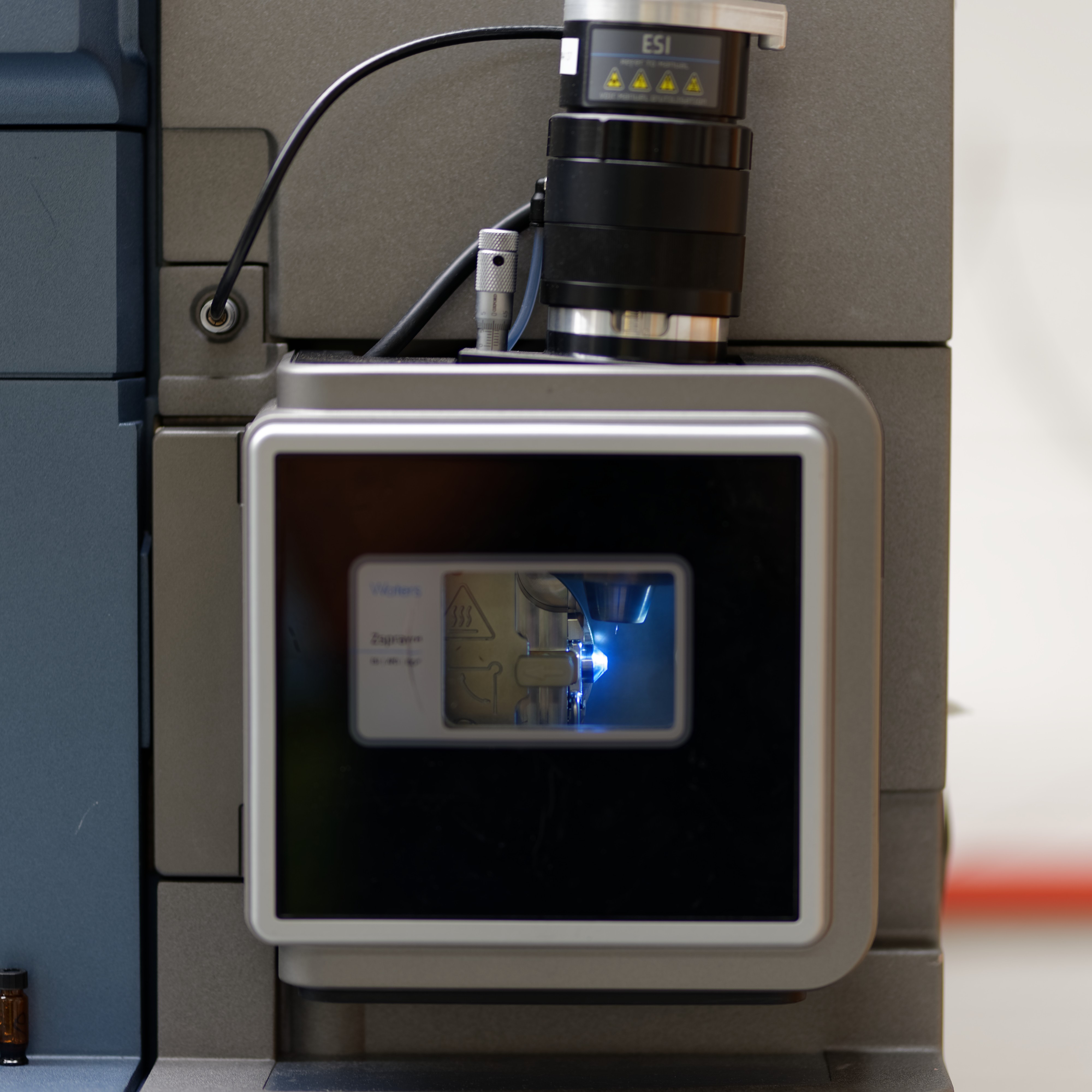Resources
The Cheema lab currently hosts 5 mass spectrometers (4 LC/MS instruments and 1 GC/MS), 1 NMR and an Agilent Seahorse XFe96 flux analyzer for the comprehensive analysis of metabolism.
Waters Xevo G2-S QTof Quadrupole Time-of-flight Mass Spectrometer

Xevo® G2-S QTof incorporates StepWave™ ion optics for unsurpassed levels of sensitivity and proven quantitative time-of-flight technology to deliver superior UPLC®-compatible mass resolution, matrix-tolerant dynamic range, quantitative performance, mass accuracy, and speed of analysis - simultaneously.
Waters Xevo G2 QTof

Xevo G2 QTof is the most sensitive, exact mass, quantitative and qualitative benchtop MS/MS system. While it maintains the integrated workflow benefits of Engineered Simplicity™ found in our existing Xevo QTof, it also incorporates the groundbreaking QuanTof™ technology of our SYNAPT™ G2 system. This means you can experience a new level of uncompromised quantitative and qualitative analytical performance in a benchtop footprint. It also means your next scientific advance is closer than ever.
Features:
- UPLC/MSE - a simple, patented method of data acquisition to comprehensively catalog complex samples in a single analysis
- QuanTof - combines innovative high-field pusher and dual-stage reflectron designs with a novel ion detection system in an optimized Tof geometry
2X Xevo TQ-S: Targeted
Waters Xevo TQ-S

XevoTM TQ from Waters Corporation is designed for quantitative UPLC/MS/MS applications, so you can confidently quantify and confirm trace components in the most complex of samples. What’s more, you can do this with unparalleled ease, speed and accuracy.
Xevo TQ features ScanWaveTM collision cell technology to provide enhanced spectral LC/MS/MS data acquisition capabilities. Unlike conventional tandem quadrupole mass spectrometers, Xevo TQ is designed to provide not only the very best quantitative data but also superior spectral MS/MS information. You benefit from more versatility in a single instrument platform adaptable to a wide variety of different UPLC/MS/MS applications both quantitative and qualitative: bioanalysis; absorption, distribution, metabolism and excretion (ADME) screening; food safety; environmental monitoring; forensic and more.
Features:
- Engineered SimplicityTM - the combination of highest performance with system versatility and simplicity of operation
- ScanWave - innovative technology that provides rapid, high quality, UPLC(R)-compatible, MS/MS data acquisition
- RADAR - an information rich acquisition approach that allows you to collect highly specific quantitative data for target compounds while providing the ability to visualize all other components
- Versatility - an extensive range of ionization capabilities to service the broadest range of applications
- Simplicity of operation - guarantees maximum system performance accessible to the broadest range of users
Seahorse XFe96 Analyzer

Seahorse XFe96 Analyzers measure OCR and ECAR of live cells in a 96-well plate format. OCR and ECAR rates are key indicators of mitochondrial respiration and glycolysis and these measurements provide a systems-level view of cellular metabolic function in cultured cells and ex-vivo samples.
- Real-time Results- this integrated system reports metabolic rates in just minutes, without sample extraction or labeling. Wave software controls the instrument and performs rate measurements on the fly for same day results.
- Live-Cell Responses – detect responses to substrates, inhibitors, and other compounds in real time via the 4-port injection system and automated mixing while maintaining physiologic temperature (37oC).
- Flexible Assay Design- the 96-well plate format accommodates many conditions in a single run and is best for dose-response studies and compound screening.
- High Sensitivity- analyze as few as 5000 cells per well in the custom 96-well plate. Cell number requirements vary by cell type; consult the Cell Reference Database for details.
- Compatible with a variety of samples due to the precision-controlled heating tray, which can maintain 16-42oC (12oC-20oC above ambient conditions).
- Measure mitochondrial function with the Seahorse XF Cell Mito Stress Test
- Generate a metabolic phenotype within one hour with the Seahorse XF Cell Energy Phenotype Test
- Measure glycolytic rates in live cells with the Seahorse XF Glycolytic Rate Assay
- Quickly determine dependency of cellular energy production on mitochondrial substrates with the Seahorse XF Mito Fuel Flex Test
- Analyze 3D samples such as spheroids and islets with the Seahorse XFe96 Spheroid Plate
- Easily create assay protocols and analyze data with Seahorse Wave software
The 7890B Gas Chromatograph (GC) System

The 7890B Gas Chromatograph (GC) System is the world’s most widely used GC system. It features accurate temperature controls and precise injection systems, plus enhanced Electronic Pneumatic Control (EPC) modules for the best retention times.
- Retention Time Locking (RTL) maintains exact retention times from injection to injection, column to column, instrument to instrument, and lab to lab
- Capillary Flow Technology (CFT) provides unique instrument capabilities, such as multi-dimension gas - chromatography (GC-GC/Deans Switch), comprehensive two-dimension gas chromatography (GCxGC) with flow modulation, and backflush at the beginning, middle, or end of the analytical column
- Single filament TCD that does not require a separate reference gas, does not require manual potentiometer adjustment, and provides a stable baseline with a minimal amount of signal drift
- Auto-ranging FID provides the ability to detect and quantitate from parts per billion (ppb) to parts per thousand in a single injection
- Integrated SCD/NCD (sulfur or nitrogen chemiluminescence detector) provides low ppb detection, equi-molar response, and quantitation for sulfur or nitrogen contaminants without quenching from matrix
- Carrier Gas Options: Helium Conservation Module, Hydrogen Sensors and Alternate Carrier Gas Solutions dramatically reduce the amount of helium used to offer flexibility in your laboratory
- Large Valve Oven (LVO) allows for the combination of multiple methods and simplified maintenance
- Multimode inlet (MMI) serves as a programmable temperature vaporizing injector with flexible capabilities
- Agilent Inert Flow Path provides increased sensitivity for active compounds, from injection to detection
- Low Thermal Mass (LTM) modules, up to 4 installed and operating, increase sample throughput with rapid column heating and cooling
Varian MR-400

The Varian MR-400 features a narrow bore 9.4 tesla/400 MHz magnet equipped with a OneNMR pulse-field-gradient probe. VNMRJ 3.0 is used for data acquisition, and the MNova software is typically used for data processing. This instrument is used for routine 1H/13C characterization experiments, routine X nucleus detection, 1D selective experiments (APT, DEPT, NOESY1D) and 2D experiments.
The OneNMR probe features autolock and autoshim, and is capable of auto tuning to nuclei from 15N - 19F. This probe uses the 1H channel for 19F experiments. Variable temperature capabilities for experiments in the range of -80 to +130 °C.
The instrument is located in New Research Building. Enquiries should be directed to Dr. Cheema or Dr. Girgis (Cheema lab GC-2/GD-4).